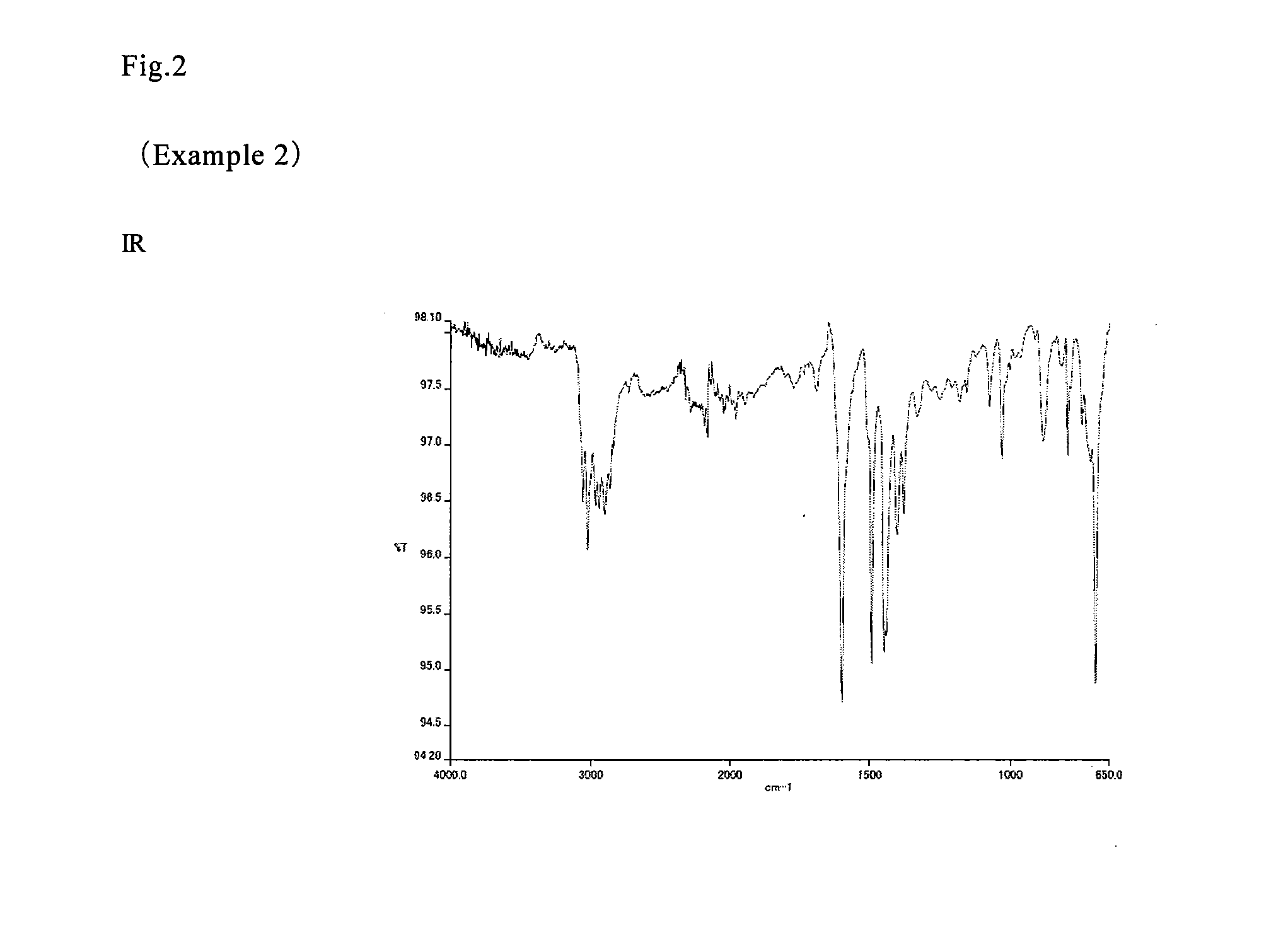Aromatic hydrocarbon resin and composition for forming underlayer film for lithography
a technology of aromatic hydrocarbon resin and composition, which is applied in the direction of photomechanical equipment, instruments, photosensitive materials, etc., can solve the problem that the resolution derived from the wavelength of light source is now approaching the essential limitation of lithography using light exposure, and achieve excellent etching resistance and excellent resist pattern
- Summary
- Abstract
- Description
- Claims
- Application Information
AI Technical Summary
Benefits of technology
Problems solved by technology
Method used
Image
Examples
example 1
[0149]In a four-neck flask having an internal capacity of 0.5 L equipped with a Dimroth condenser, a thermometer and stirring blades, 53 g (0.5 mol) of m-xylene (produced by Mitsubishi Gas Chemical Co., Inc.), 53 g (0.5 mol) of benzaldehyde (produced by Wako Pure Chemical Industries, Ltd.) and 5.3 g of 12 tungsto(VI) phosphoric acid n-hydrate (produced by Wako Pure Chemical Industries, Ltd.) were placed under a nitrogen stream, and heated to 140° C. and reacted for 5 hours. After diluting with 212 g of methyl isobutyl ketone (produced by Wako Pure Chemical Industries, Ltd.), the reaction mixture was neutralized and washed with water, and the solvent was removed under reduced pressure, thereby providing 61.2 g of a resin (NF-1).
[0150]The results of the GPC analysis were Mn: 683, Mw: 1,204, and Mw / Mn: 1.76. The results of the organic elemental analysis were a carbon concentration of 91.4% by mass and an oxygen concentration of 0.2% by mass.
example 2
[0151]In a four-neck flask having an internal capacity of 0.5 L equipped with a Dimroth condenser, a thermometer and stirring blades, 54.6 g (0.35 mol) of 1,5-dimethylnaphthalene (produced by Mitsubishi Gas Chemical Co., Inc.), 74.2 g (0.7 mol) of benzaldehyde (produced by Wako Pure Chemical Industries, Ltd.) and 5.2 g of 12 tungsto(VI) phosphoric acid n-hydrate (produced by Wako Pure Chemical Industries, Ltd.) were placed under a nitrogen stream, and heated to 150° C. and reacted for 8 hours. After diluting with 386 g of methyl isobutyl ketone (produced by Wako Pure Chemical Industries, Ltd.), the reaction mixture was neutralized and washed with water, and the solvent was removed under reduced pressure, thereby providing 48.9 g of a resin (NF-2).
[0152]The results of the GPC analysis were Mn: 835, Mw: 1,515, and Mw / Mn: 1.81. The results of the organic elemental analysis were a carbon concentration of 92.8% by mass and an oxygen concentration of 0.4% by mass. The results of the 1H- a...
example 3
[0155]In a four-neck flask having an internal capacity of 0.5 L equipped with a Dimroth condenser, a thermometer and stirring blades, 78 g (0.5 mol) of 1,5-dimethylnaphthalene (produced by Mitsubishi Gas Chemical Co., Inc.), 30.5 g (0.25 mol) of hydroxybenzaldehyde (produced by Wako Pure Chemical Industries, Ltd.) and 1.1 g of p-toluenesulfonic acid (produced by Wako Pure Chemical Industries, Ltd.) were placed under a nitrogen stream, and heated to 120° C. and reacted for 3 hours. After diluting with 326 g of methyl isobutyl ketone (produced by Wako Pure Chemical Industries, Ltd.), the reaction mixture was neutralized and washed with water, and the solvent was removed under reduced pressure, thereby providing 79.3 g of a resin (NF-3).
[0156]The results of the GPC analysis were Mn: 1,231, Mw: 3,982, and Mw / Mn: 3.23. The results of the organic elemental analysis were a carbon concentration of 90.1% by mass and an oxygen concentration of 4.1% by mass.
PUM
| Property | Measurement | Unit |
|---|---|---|
| temperature | aaaaa | aaaaa |
| reaction time | aaaaa | aaaaa |
| reaction time | aaaaa | aaaaa |
Abstract
Description
Claims
Application Information
 Login to View More
Login to View More - R&D
- Intellectual Property
- Life Sciences
- Materials
- Tech Scout
- Unparalleled Data Quality
- Higher Quality Content
- 60% Fewer Hallucinations
Browse by: Latest US Patents, China's latest patents, Technical Efficacy Thesaurus, Application Domain, Technology Topic, Popular Technical Reports.
© 2025 PatSnap. All rights reserved.Legal|Privacy policy|Modern Slavery Act Transparency Statement|Sitemap|About US| Contact US: help@patsnap.com



